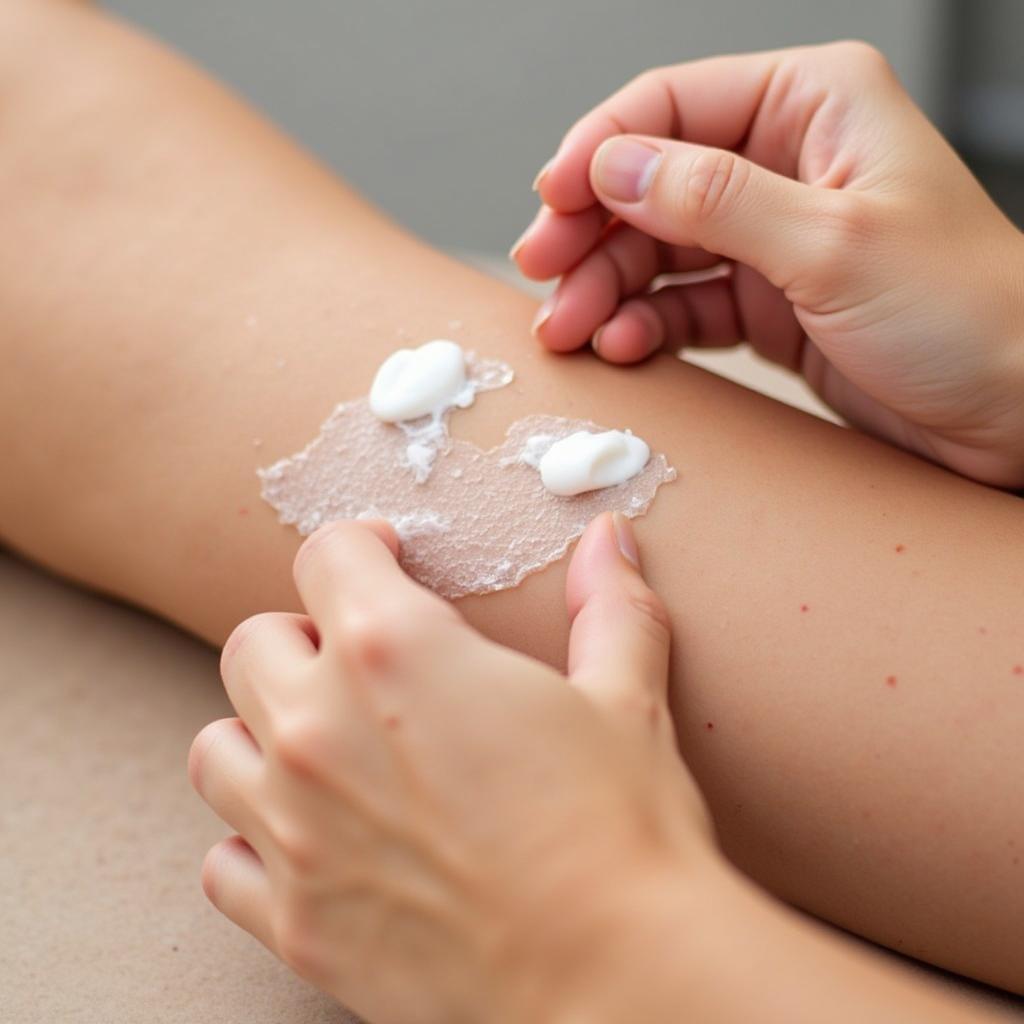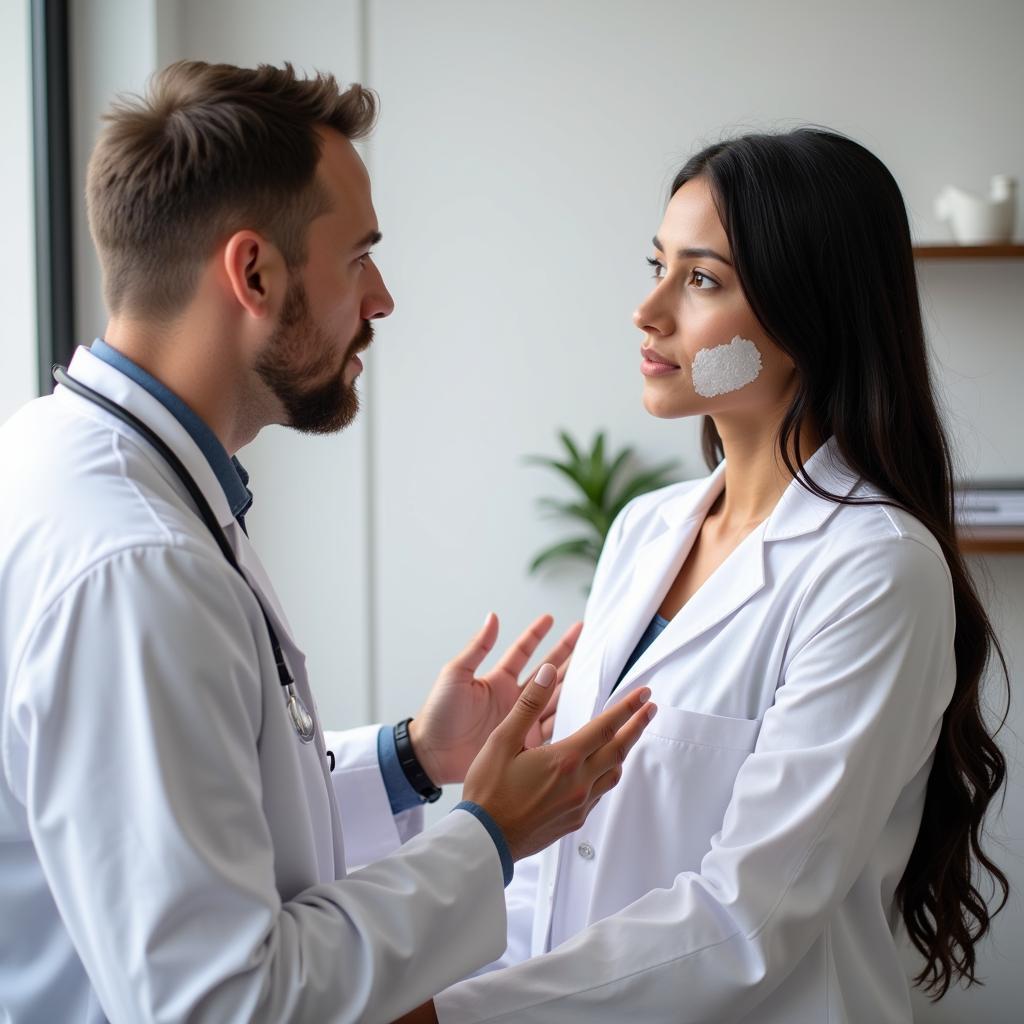Finding the Best Cream For Vitiligo In Pakistan can feel like navigating a maze. With countless products promising miraculous results, it’s easy to feel overwhelmed. This comprehensive guide aims to illuminate your path, providing evidence-based information to help you make informed decisions about managing your vitiligo.
Understanding Vitiligo and Its Impact
Vitiligo is a skin condition characterized by the loss of pigment, resulting in white patches on the skin. While not physically harmful, its impact on self-esteem and emotional well-being can be significant.
 Close-up of vitiligo patches on skin
Close-up of vitiligo patches on skin
Types of Creams for Vitiligo Treatment in Pakistan
Several types of creams are available in Pakistan for vitiligo treatment, each working through different mechanisms:
1. Corticosteroid Creams: These creams work by reducing inflammation and suppressing the immune system’s attack on melanocytes (pigment-producing cells). They are often the first line of treatment, especially for localized vitiligo.
2. Calcineurin Inhibitor Creams: These creams, like tacrolimus and pimecrolimus, also modulate the immune response but have a different mechanism of action than corticosteroids. They are generally considered safer for long-term use, particularly on sensitive areas of the skin.
3. Topical Immunomodulators: These newer medications, often containing ingredients like ruxolitinib, work by targeting specific pathways involved in the immune response in vitiligo. They have shown promise in clinical trials and may offer a more targeted approach.
 Applying cream to vitiligo affected area
Applying cream to vitiligo affected area
Choosing the Best Cream for You: Factors to Consider
1. Type and Severity of Vitiligo: The effectiveness of creams can vary depending on the type of vitiligo (e.g., generalized, segmental) and its severity.
2. Skin Type and Sensitivity: Certain creams may not be suitable for all skin types, particularly for individuals with sensitive skin.
3. Medical History and Current Medications: It’s crucial to discuss your medical history, including any allergies or pre-existing conditions, with your doctor to avoid potential interactions.
4. Realistic Expectations: While some individuals experience repigmentation with topical creams, results can vary widely. It’s essential to have realistic expectations and understand that vitiligo treatment often requires a multifaceted approach.
Beyond Creams: Complementary Treatment Options
1. Phototherapy: This treatment involves exposing the skin to specific wavelengths of ultraviolet light, which can stimulate melanocyte activity and promote repigmentation.
2. Oral Medications: In some cases, your doctor may prescribe oral medications, such as corticosteroids or immunosuppressants, to manage vitiligo, particularly for more widespread cases.
3. Camouflage Therapy: This option involves using specialized cosmetics to conceal depigmented patches, helping individuals feel more confident in their appearance.
 Dermatologist consults patient with vitiligo
Dermatologist consults patient with vitiligo
Expert Insights: Dr. Ayesha Khan, Leading Dermatologist in Lahore
“It’s crucial to remember that vitiligo treatment is highly individualized,” says Dr. Ayesha Khan, a leading dermatologist in Lahore, Pakistan. “What works best for one person might not be the most effective option for another. Open communication with your dermatologist is vital to develop a tailored treatment plan that addresses your unique needs and goals.”
Frequently Asked Questions (FAQs)
1. How long does it take for vitiligo creams to show results?
Results with vitiligo creams typically appear gradually over several weeks to months of consistent use. It’s important to be patient and follow your dermatologist’s instructions.
2. Are there any side effects of using vitiligo creams?
Like any medication, vitiligo creams can have potential side effects, although they are usually mild and temporary. Common side effects include skin thinning, dryness, irritation, or changes in skin pigmentation.
3. Can I use natural remedies alongside vitiligo creams?
While some natural remedies are touted for their potential benefits in managing vitiligo, it’s essential to consult with your dermatologist before using them, as they may interact with prescribed medications or have unforeseen side effects.
Conclusion: Embracing a Holistic Approach to Vitiligo Management
Finding the best cream for vitiligo in Pakistan is a journey that requires collaboration with a qualified dermatologist and realistic expectations. While creams can be a valuable part of a comprehensive treatment plan, combining them with other modalities, such as phototherapy or camouflage therapy, may offer optimal outcomes. Remember, managing vitiligo is about finding what works best for you, both physically and emotionally.
If you need support in your journey with vitiligo, don’t hesitate to contact us. Our dedicated team of experts is available 24/7 to provide guidance and answer any questions you may have.
Call: +923337849799
Email: [email protected]
Visit: Dera Ghazi Khan Rd, Rakhni, Barkhan, Balochistan, Pakistan.